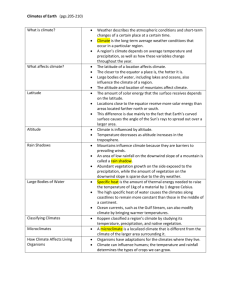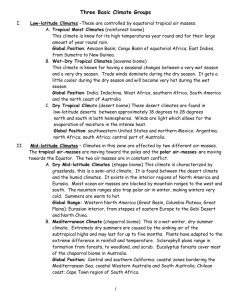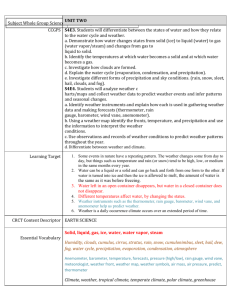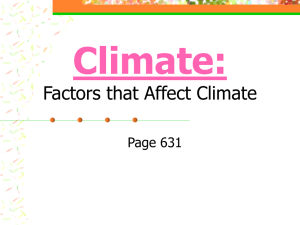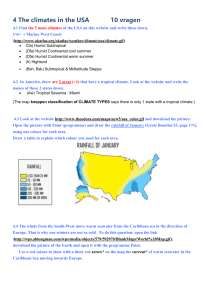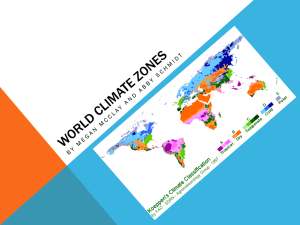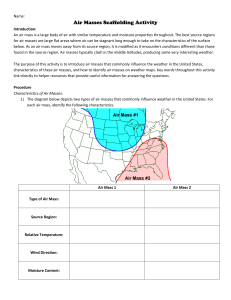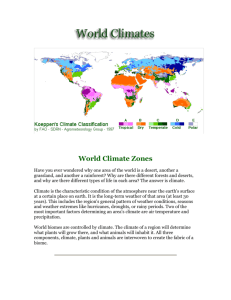Climate Zones Reading
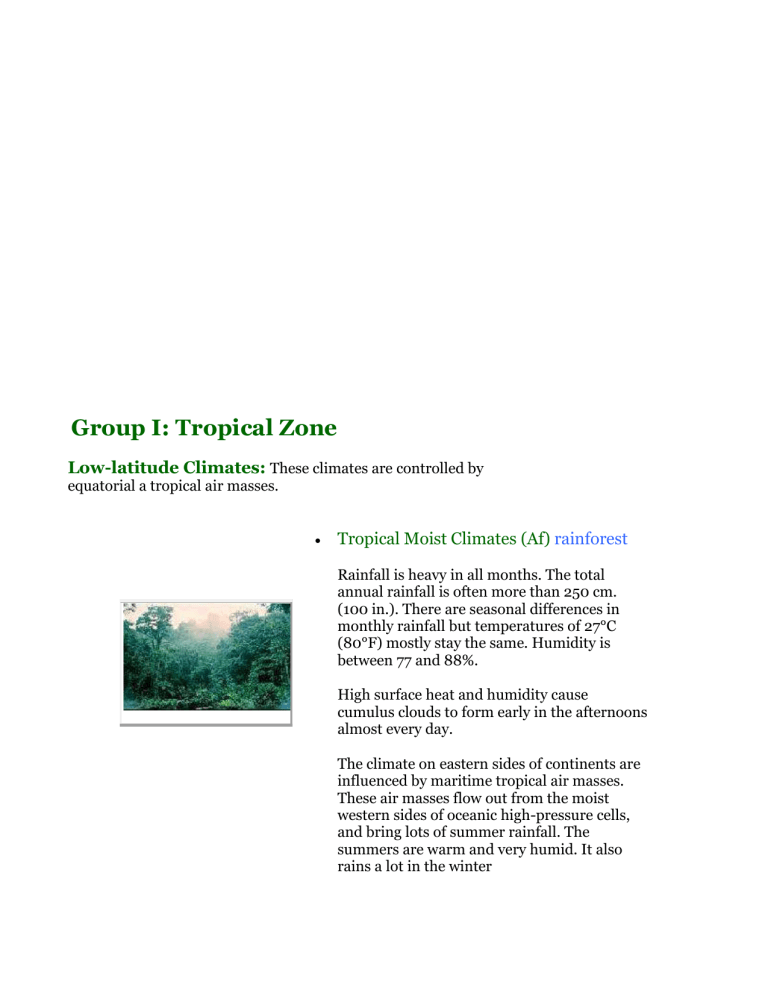
Group I: Tropical Zone
Low-latitude Climates:
These climates are controlled by equatorial a tropical air masses.
Tropical Moist Climates (Af) rainforest
Rainfall is heavy in all months. The total annual rainfall is often more than 250 cm.
(100 in.). There are seasonal differences in monthly rainfall but temperatures of 27°C
(80°F) mostly stay the same. Humidity is between 77 and 88%.
High surface heat and humidity cause cumulus clouds to form early in the afternoons almost every day.
The climate on eastern sides of continents are influenced by maritime tropical air masses.
These air masses flow out from the moist western sides of oceanic high-pressure cells, and bring lots of summer rainfall. The summers are warm and very humid. It also rains a lot in the winter
o o o o
Average temperature: 18 °C (°F)
Annual Precipitation: 262 cm. (103 in.)
Latitude Range: 10° S to 25 ° N
Global Position: Amazon Basin; Congo
Basin of equatorial Africa; East Indies, from Sumatra to New Guinea.
Wet-Dry Tropical Climates (Aw) savanna
A seasonal change occurs between wet tropical air masses and dry tropical air masses. As a result, there is a very wet season and a very dry season. Trade winds dominate during the dry season. It gets a little cooler during this dry season but will become very hot just before the wet season. o o o o
Temperature Range: 16 °C
Annual Precipitation: 0.25 cm. (0.1 in.). All months less than 0.25 cm. (0.1 in.)
Latitude Range: 15 ° to 25 ° N and S
Global Range: India, Indochina, West
Africa, southern Africa, South America and the north coast of Australia
Dry Tropical Climate (BW) desert biome
These desert climates are found in lowlatitude deserts approximately between 18° to
28° in both hemispheres. these latitude belts are centered on the tropics of Cancer and
Capricorn, which lie just north and south of the equator. They coincide with the edge of the equatorial subtropical high pressure belt and trade winds. Winds are light, which allows for the evaporation of moisture in the intense heat. They generally flow downward so the area is seldom penetrated by air masses that produce rain. This makes for a very dry heat. The dry arid desert is a true desert climate, and covers 12 % of the Earth's land surface.
o Temperature Range: 16° C
o o o
Annual Precipitation: 0.25 cm (0.1 in). All months less than 0.25 cm (0.1 in).
Latitude Range: 15° - 25° N and S.
Global Range: southwestern United States and northern Mexico; Argentina; north
Africa; south Africa; central part of
Australia.
Group II: Temperate Zone
Mid-latitude Climates:
Climates in this zone are affected by two different air-masses. The tropical air-masses are moving towards the poles and the polar air-masses are moving towards the equator. These two air masses are in constant conflict. Either air mass may dominate the area, but neither has exclusive control.
Dry Midlatitude Climates (BS) steppe
Characterized by grasslands, this is a semiarid climate. It can be found between the desert climate
(BW) and more humid climates of the A, C, and D groups. If it received less rain, the steppe would be classified as an arid desert. With more rain, it would be classified as a tallgrass prairie.
This dry climate exists in the interior regions of the North American and Eurasian continents.
Moist ocean air masses are blocked by mountain ranges to the west and south. These mountain ranges also trap polar air in winter, making winters very cold. Summers are warm to hot.
o o o o
Temperature Range: 24° C (43° F).
Annual Precipitation: less than 10 cm (4 in) in the driest regions to 50 cm (20 in) in the moister steppes.
Latitude Range: 35° - 55° N.
Global Range: Western North America (Great
Basin, Columbia Plateau, Great Plains);
Eurasian interior, from steppes of eastern
Europe to the Gobi Desert and North China.
Mediterranean Climate (Cs) chaparral biome
This is a wet-winter, dry-summer climate.
Extremely dry summers are caused by the sinking air of the subtropical highs and may last for up to five months.
Plants have adapted to the extreme difference in rainfall and temperature between winter and summer seasons. Sclerophyll plants range in formations from forests, to woodland, and scrub.
Eucalyptus forests cover most of the chaparral biome in Australia.
Fires occur frequently in Mediterranean climate zones.
o o o o
Temperature Range: 7 °C (12 °F)
Annual Precipitation: 42 cm (17 in).
Latitude Range: 30° - 50° N and S
Global Position: central and southern
California; coastal zones bordering the
Mediterranean Sea; coastal Western Australia and South Australia; Chilean coast; Cape Town region of South Africa.
Dry Midlatitude Climates (Bs) grasslands biome
These dry climates are limited to the interiors of
North America and Eurasia.
Ocean air masses are blocked by mountain ranges to the west and south. This allows polar air masses to dominate in winter months. In the summer, a local continental air mass is dominant. A small amount of rain falls during this season.
Annual temperatures range widely. Summers are
warm to hot, but winters are cold.
o o o o
Temperature Range: 31 °C (56°F).
Annual Precipitation: 81 cm. (32 in.).
Latitude Range: 30° - 55° N and S
Global Position: western North America (Great
Basin, Columbia Plateau, Great Plains);
Eurasian interior.
Moist Continental Climate (Cf) Deciduous
Forest biome
This climate is in the polar front zone - the battleground of polar and tropical air masses.
Seasonal changes between summer and winter are very large. Daily temperatures also change often.
Abundant precipitation falls throughout the year.
It is increased in the summer season by invading tropical air masses. Cold winters are caused by polar and arctic masses moving south. o o o o
Temperature Range: 31 °C (56 ° F)
Average Annual Precipitation: 81 cm (32 in).
Latitude Range: 30° - 55° N and S (Europe: 45°
- 60° N).
Global Position: eastern parts of the United
States and southern Canada; northern China;
Korea; Japan; central and eastern Europe.
Group III: Polar Zone
High-latitude climates:
Polar and arctic air masses dominate these regions. Canada and Siberia are two air-mass sources which fall into this group. A southern hemisphere counterpart to these continental centers does not exist. Air masses of arctic origin meet polar continental air masses along the 60th and 70th
parallels.
Boreal forest Climate ( Dfc) taiga biome
This is a continental climate with long, very cold winters, and short, cool summers. This climate is found in the polar air mass region. Very cold air masses from the arctic often move in. The temperature range is larger than any other climate. Precipitation increases during summer months, although annual precipitation is still small.
Much of the boreal forest climate is considered humid. However, large areas in western Canada and Siberia receive very little precipitation and fall into the subhumid or semiarid climate type.
o o o o Temperature Range: 41 °C (74 °F), lows; -25 °C
(-14 °F), highs; 16 °C (60 °F).
Average Annual Precipitation: 31 cm (12 in).
Latitude Range: 50° - 70° N and S.
Global Position: central and western Alaska;
Canada, from the Yukon Territory to Labrador;
Eurasia, from northern Europe across all of
Siberia to the Pacific Ocean.
Tundra Climate (E) tundra biome
The tundra climate is found along arctic coastal areas. Polar and arctic air masses dominate the tundra climate. The winter season is long and severe. A short, mild season exists, but not a true summer season. Moderating ocean winds keep the temperatures from being as severe as interior regions.
o o o o Temperature Range: -22 °C to 6 °C (-10 °F to
41 °F).
Average Annual Precipitation: 20 cm (8 in).
Latitude Range: 60° - 75° N.
Global Position: arctic zone of North America;
Hudson Bay region; Greenland coast; northern
Siberia bordering the Arctic Ocean.
Highland Climate (H) Alpine Biome
Highland climates are cool to cold, found in mountains and high plateaus. Climates change rapidly on mountains, becoming colder the higher the altitude gets. The climate of a highland area is closely related to the climate of the surrounding biome. The highlands have the same seasons and wet and dry periods as the biome they are in.
Mountain climates are very important to midlatitude biomes. They work as water storage areas. Snow is kept back until spring and summer when it is released slowly as water through melting.
o o o o Temperature Range: -18 °C to 10 °C (-2 °F to
50°F)
Average Annual Precipitation: 23 cm (9 in.)
Latitude Range: found all over the world
Global Position: Rocky Mountain Range in
North America, the Andean mountain range in
South America, the Alps in Europe, Mt.
Kilimanjaro in Africa, the Himalayans in Tibet,
Mt. Fuji in Japan.
Bibliography:
Strahler, Arthur N., Strahler, Arthur H., Elements of Physical Geography. John Wiley & Sons,
1984.
